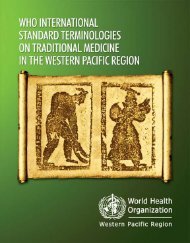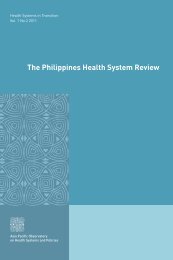Download pdf, 989kb - WHO Western Pacific Region - World Health ...
Download pdf, 989kb - WHO Western Pacific Region - World Health ...
Download pdf, 989kb - WHO Western Pacific Region - World Health ...
You also want an ePaper? Increase the reach of your titles
YUMPU automatically turns print PDFs into web optimized ePapers that Google loves.
A Review of Literature and Projects 2005<br />
(3) Protection against abuse and<br />
exploitation<br />
The Child Act 2001, which covers<br />
persons under the age of 18 years and is<br />
in line with the Convention on the Rights<br />
of Child, provides protection for<br />
children against abuse, exploitation and<br />
violence. It is a promulgation of three<br />
acts: the 1947 Juvenile Court Act; the<br />
1973 Protection of Women and Girls<br />
Act; and the 1991 Protection of Children<br />
Act. The Penal Code (Act 574) addresses<br />
a minimum age for specific offences. The<br />
law protects children from being sold or<br />
bought for the purpose of prostitution:<br />
“Whoever buys, hires or otherwise<br />
obtains possession of any person under<br />
the age of 21 years with intent that such<br />
person shall be employed or used for the<br />
purpose of prostitution or illicit<br />
intercourse shall be punished with<br />
imprisonment for a term which may<br />
extend to ten years and shall be liable to<br />
a fine.” A section addresses kidnapping<br />
of a minor from lawful guardianship. It<br />
states that “whoever takes or entices any<br />
minor under 14 years for male, and<br />
16 years for female, out of keeping of<br />
the lawful guardian of such minor,<br />
without consent of such guardian, is said<br />
to kidnap such minor from lawful<br />
guardianship”. Regarding consent for<br />
sexual relationships, the age of consent<br />
is 16 years for females and 13 years for<br />
males. Any sexual relationship below the<br />
age of consent is statutory rape<br />
(4) Access to obscene materials<br />
The sale of obscene objects to young<br />
persons is addressed in Section 293 of<br />
the Penal Code. It states that “whoever<br />
sells, lets to hire, distribute, exhibits or<br />
circulates to any person under the age<br />
of 20 years any such obscene objects or<br />
offers or attempts so to do, shall be<br />
punished with imprisonment for a term<br />
which may extend to five years or with a<br />
fine or with both.” While the control of<br />
obscene material on the Internet is a very<br />
challenging issue, there are several cyber<br />
laws that can be applied to protect young<br />
people from such negative influences.<br />
(5) Access to and use of substances<br />
(drugs and tobacco)<br />
It is common for adolescents who use<br />
drugs and alcohol to engage in risky types<br />
of behaviour, including sex. Pertinent to<br />
this is the law governing the sale of<br />
tobacco products, by which a seller<br />
commits a crime if he sells tobacco to<br />
persons below 18 years.<br />
3.4. Interventions<br />
The review revealed that some<br />
interventions have been put in place to<br />
respond to adolescent sexual and<br />
reproductive health needs. While there<br />
are many kinds of intervention, two<br />
major types are described: education and<br />
47

















